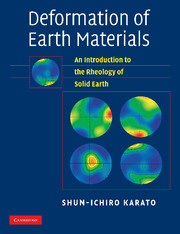Book contents
- Frontmatter
- Contents
- Preface
- Part I General background
- Part II Materials science of deformation
- 4 Elasticity
- 5 Crystalline defects
- 6 Experimental techniques for study of plastic deformation
- 7 Brittle deformation, brittle–plastic and brittle–ductile transition
- 8 Diffusion and diffusional creep
- 9 Dislocation creep
- 10 Effects of pressure and water
- 11 Physical mechanisms of seismic wave attenuation
- 12 Deformation of multi-phase materials
- 13 Grain size
- 14 Lattice-preferred orientation
- 15 Effects of phase transformations
- 16 Stability and localization of deformation
- Part III Geological and geophysical applications
- References
- Materials index
- Subject index
- Plate section
11 - Physical mechanisms of seismic wave attenuation
Published online by Cambridge University Press: 05 June 2012
- Frontmatter
- Contents
- Preface
- Part I General background
- Part II Materials science of deformation
- 4 Elasticity
- 5 Crystalline defects
- 6 Experimental techniques for study of plastic deformation
- 7 Brittle deformation, brittle–plastic and brittle–ductile transition
- 8 Diffusion and diffusional creep
- 9 Dislocation creep
- 10 Effects of pressure and water
- 11 Physical mechanisms of seismic wave attenuation
- 12 Deformation of multi-phase materials
- 13 Grain size
- 14 Lattice-preferred orientation
- 15 Effects of phase transformations
- 16 Stability and localization of deformation
- Part III Geological and geophysical applications
- References
- Materials index
- Subject index
- Plate section
Summary
All materials show some deviation from perfect elasticity particularly at low frequencies and/or high temperatures. In geophysics, this effect can be seen as the attenuation of seismic waves, but it can also be seen as a reduction in seismic wave velocities. Many of the physical processes causing this effect involve the motion of crystalline defects (dislocations, grain boundaries) and are sensitive to temperature, grain size and the chemical environment such as the fugacity of water. This chapter provides a review of the solid-state mechanisms of seismic wave attenuation as well as those involving partial melt. Understanding the physical mechanisms of anelasticity (or visco-elasticity) is critical for the inference of distribution of temperature, grain size, water content and other variables describing physico-chemical environment such as the presence of partial melt from seismic wave attenuation (Chapters 18, 20).
Key words anelasticity, visco-elasticity, Q, velocity dispersion, Maxwell model, Voigt model, standard linear solid, Burgers model, absorption band model, melt squirt, Walsh model, Zener mechanism (thermoelasticity), Bordoni peak, Snoek peak, Kê peak, bulk attenuation.
Introduction
Understanding the microscopic mechanisms for anelasticity is critical for the interpretation of seismic wave attenuation in terms of the physical and chemical state of Earth's interior (e.g., jackson, 2000) and for the study of tidal dissipation that controls the thermal history and orbital evolution of planets (e.g., kaula, 1964). The phenomenological theory of anelastic (or visco-elastic) behavior is reviewed in Chapter 3.
- Type
- Chapter
- Information
- Deformation of Earth MaterialsAn Introduction to the Rheology of Solid Earth, pp. 199 - 213Publisher: Cambridge University PressPrint publication year: 2008



